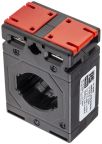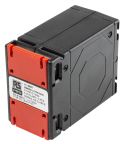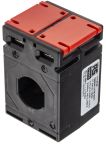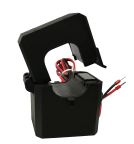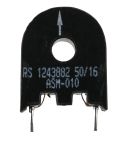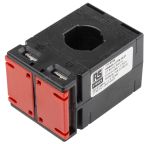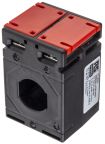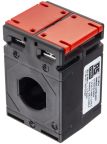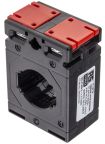Current Transformers
Current transformers (CTs), also known as instrument transformers, are devices used to measure alternating current (AC) without direct connection. They work by reducing a high primary current to a lower, more manageable secondary current proportional to the original. This allows for safe and accurate measurement using standard ammeters or other instruments. The amount of reduction depends on the CT's turn ratio.
Current transformers consist of a primary winding, a secondary winding, and a magnetic core. The primary winding carries the high current, while the secondary winding connects to the measuring instrument with multiple turns. The magnetic field created by the primary current induces a proportional current in the secondary winding, enabling accurate measurement.
Current transformers are essential in various applications, including power monitoring, protection relays and energy metering. This offers a safe and efficient way to measure high currents in AC circuits.
How Does a Current Transformer Work?
Also known as "step-down transformers," current transformers measure alternating current (AC) indirectly. When AC flows through the primary winding, it creates a magnetic flux that induces a proportional current in the secondary winding, allowing for safe monitoring and measuring using an ammeter.
Here's a breakdown of the key components and principles involved:
- Primary Winding: The primary winding of a current transformer typically consists of a single conductor carrying the high current to be measured. It acts as the primary coil in the transformer, generating the magnetic field that induces current in the secondary winding.
- Secondary Winding: The secondary winding of a current transformer has multiple turns of wire wrapped around the magnetic core. It acts as the secondary coil, receiving the induced current from the primary winding. This current is then used for measurement or to drive other devices.
- Magnetic Field: The magnetic field generated by the primary winding is the key to the current transformer’s operation. This field links the primary and secondary windings, enabling the transfer of energy and the induction of current in the secondary winding.
- Induced Voltage: While the primary purpose of a current transformer is to measure current, an induced voltage is also present across the secondary winding. This voltage is proportional to the rate of change of the magnetic field and can be used for other applications, such as protection relays.
Functions of Current Transformers
Current transformers serve several crucial functions in electrical systems, making them essential components in various applications. These include:
- Current Measurement: The primary function of a current transformer is to accurately measure alternating current (AC) in a circuit without direct connection. By stepping down the high current to a lower, manageable level, current transformers enable safe and precise measurement using standard ammeters or other measuring instruments.
- Isolation: Current transformers provide electrical isolation between the high-voltage primary circuit and the low-voltage secondary circuit. This isolation protects sensitive measuring instruments and personnel from the dangers of high voltages, ensuring safety and preventing damage to equipment.
Benefits of Current Transformers
Current transformers (CTs) offer several advantages that make them indispensable in electrical systems:
- Security: CTs provide electrical isolation between high-voltage circuits and low-voltage measuring instruments ensuring safety during operation.
- Safety/Accident Prevention: Industrial current transformers help prevent accidents by allowing safe monitoring of high currents without direct contact with live conductors.
- Convenience: CTs simplify complex wiring setups by providing standardised connections for measuring devices.
Types of Current Transformers
Current transformers are categorised into various types based on their construction, core material and application. Understanding these different types is essential for selecting the right current transformer for your specific needs.
Based on Construction Type
- Toroidal Current Transformer: Shaped like a doughnut, these transformers are unique in that they don't have a dedicated primary winding. Instead, the conductor carrying the current to be measured simply passes through the central hole (or window) of the toroidal transformer, effectively acting as the primary winding.
- Wound Current Transformer: These transformers have a distinct primary winding that may be physically connected in series with the conductor or simply pass through the core to measure current. This direct connection allows for accurate measurement of the current flowing through the circuit.
- Bar-type Current Transformer: In this type of transformer, the main circuit's cable or busbar itself acts as the primary winding, effectively forming a single turn. These transformers are typically bolted directly to the current-carrying device and are fully insulated to ensure safe operation at high voltages.
- Split Core Type Current Transformer: Designed for easy installation, these CTs feature a split core that allows them to be clamped around the conductor without disconnecting it. This non-invasive design makes them ideal for retrofitting or applications where interrupting the circuit is impractical.
- Industrial Current Transformer: Built for demanding industrial environments, these transformers are typically larger and more robust, capable of handling high currents and harsh conditions. They often feature high accuracy and stability, making them suitable for critical measurements in power systems and industrial processes**.**
Based on Mounting Type
- Clip On Current Transformer: These current transformers offer convenient and non-invasive current measurement. They feature a core that can be opened or hinged, allowing them to be easily clamped around a conductor without disconnecting it.
- Surface Mount Current Transformer: Designed for compact installations, these transformers are directly mounted onto a surface, such as a printed circuit board or a panel.
- PCB Mount Current Transformer: Specifically designed for printed circuit board (PCB) applications, these transformers offer a compact size and easy integration into electronic circuits.
Based on Application Type
- Indoor CTs: Designed for use in indoor environments, these current transformers are typically housed in protective enclosures to shield them from dust, moisture and other contaminants.
- **Outdoor CTs: **Built to withstand harsh outdoor conditions, these current transformers feature weatherproof enclosures and robust construction to protect them from rain, snow, UV radiation and extreme temperatures.
Applications of Current Transformers
Current transformers play a vital role in various industries and applications, providing safe and accurate current measurement for monitoring, control and protection purposes. Their ability to measure high currents indirectly makes them indispensable in diverse sectors, including:
Power System Protection
Current transformers are essential components in power system protection schemes, ensuring the safety and reliability of electrical networks. They provide accurate current measurements for various protection functions, such as:
- Overcurrent Protection: Current transformers monitor current levels and trigger protective devices, such as relays or circuit breakers, to isolate faulty sections of the network in case of overcurrents or short circuits.
- Earth Fault Protection: Current transformers detect earth faults, which occur when current flows to earth through an unintended path. This helps protect personnel and equipment from electrical hazards.
- Motor Protection: Current transformers are used in motor protection relays to monitor motor currents, providing protection against overloads, phase imbalances and other faults that can damage the motor. Contactors, guided by current transformer signals, often switch high-power motor circuits.
Energy Metering
Current transformers are crucial components in energy metering systems, enabling accurate measurement of electricity consumption for billing and energy management purposes.
- Residential and Commercial Metering: Current transformers are used in electricity meters to measure the amount of power consumed by homes and businesses, providing data for billing and energy consumption analysis.
- Industrial Metering: In industrial settings, current transformers enable precise measurement of energy consumption for individual machines, processes or entire facilities, facilitating energy efficiency monitoring and cost optimisation.
Control and Automation
Current transformers play a vital role in control and automation systems, providing accurate current measurements for feedback and control loops.
- PLC Systems: In Programmable Logic Controller (PLC) systems, current transformers provide current data to the PLC, enabling precise control of motors, drives and other automated processes.
- Motor Control Centres: Current transformers are essential components in motor control centres (MCCs), providing current monitoring and protection for individual motors or groups of motors in industrial settings.
Testing and Calibration
Current transformers play a crucial role in ensuring the accuracy of other measuring instruments and electrical equipment.
- Calibration of Ammerters: Precise current transformers are used to calibrate ammeters and other current-measuring devices — including digital multimeters with current measurement capabilities — ensuring their readings are accurate and reliable.
- Testing of Electrical Equipment: Current transformers are used in testing procedures for various electrical equipment — such as circuit breakers and relays — to simulate real-world conditions and verify their performance under different load scenarios.
Get Your Current Transformers from RS Singapore
As a trusted supplier of high-quality current transformers — as well as related products such as clamp meters and data loggers — RS Singapore offers a wide range of options from leading manufacturers like Carlo Gavazzi and Murata Power Solutions. Whether you need a split-core current transformer for easy installation or a solid core current transformer for heavy duty applications, we have the solution for you.
Explore our selection online, add your desired current transformers to your cart and enjoy a secure and convenient checkout process. We also offer various payment options and fast delivery across Singapore, with flexible solutions to suit your needs.
For detailed information on delivery services and costs, visit our Delivery Information page. Ensure accurate and reliable current measurement with our high-quality current transformers — order from RS Singapore today!
Popular Searches
Related links
- PCB Connectors & Wire Housings
- Socomec 192T Series Split Core Current Transformer 1000:5
- Schneider Electric LVCT Series Split Core Current Transformer 0.333 V
- Schneider Electric PowerLogic Series Split Core Current Transformer 1000/5A 720 V
- WAGO 855 Series Split Core Current Transformer 1000:5, 5 A Output
- Split Core Current Transformer
- RS PRO Split Core Current Transformer 120:1 32.5mm Bore
- RS PRO Split Core Current Transformer 25:1 18.5mm Bore
